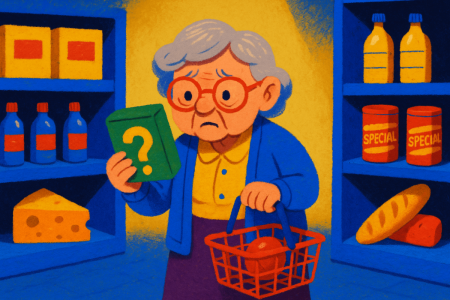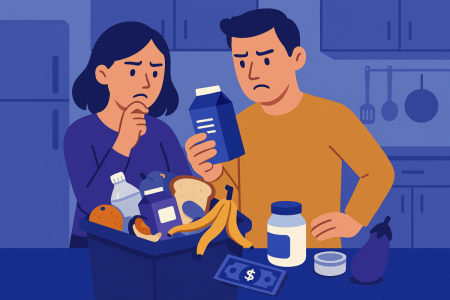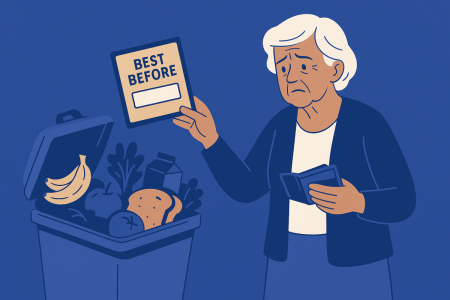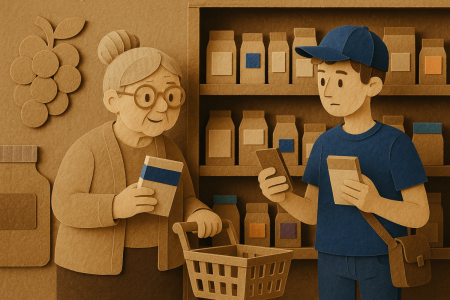Why senior shoppers are demanding clearer labels
- Replies 49
Ever felt like you need a magnifying glass just to read a soup can? You’re not alone. Across Australia, especially among over-60 shoppers, there’s a growing chorus of “We can’t read this!” when it comes to food and product labels.
From supermarket shelves to medicine cabinets, older Aussies are finding that confusing, hard-to-read labels are more than just a nuisance – they’re hitting us in the hip pocket and even affecting our health.
It turns out the fine print isn’t just giving us eye strain; it’s contributing to wasted food, wasted money, and wasted confidence at the shops.
So, what’s going on with product labels, and why are seniors leading the drive for clearer, honest packaging? Let’s peel back the label (with readable font, of course) and find out.
How big is the problem? Australians waste a staggering 7.6 million tonnes of food each year, much of it still fine to eat. For the average household, that could mean up to $2,500 thrown in the bin annually thanks in part to label confusion.
Older Australians on fixed incomes feel this waste especially keenly. National Seniors Australia (NSA) – the peak body for older citizens – warned a Senate inquiry that “confusing food labels are costing older Australians” by causing them to discard food unnecessarily. The core issue? People often misinterpret “best before” dates or storage instructions printed in microscopic text, or they miss them entirely.
The RMIT study’s lead author, Associate Professor Lukas Parker, put it bluntly: “Australian shoppers deserve better than this. They’re being let down by labels that don’t give them the information they need to make the right call”. In other words, unclear labels are sabotaging even the best intentions to avoid waste.
The solution, researchers say, is straightforward: use bigger text, plain language and simple icons for key info like dates and storage. Instead of a cryptic “DISPLAY UNTIL 01/07” on an egg carton, how about a bold “Best before 1 July – do not eat after this date” on products that truly expire?
Trials of such redesigned labels found that both consumers and industry folks overwhelmingly preferred “clear, concise, and visually distinct” date labels and storage advice. It turns out nobody really likes fine print – not even the people who make the products.
Yet, despite consumers practically begging for clearer labels, progress has been slow. Industry insiders often hesitate, citing concerns about cost and regulatory headaches if they have to overhaul all their packaging.
There’s also a bit of finger-pointing: a report on the RMIT study noted that some in the food industry see household waste as the consumer’s problem, preferring education campaigns over changing their own packaging practices. In other words, “Read our tricky labels better!” rather than “Let’s make our labels easier to read.”
But as End Food Waste Australia CEO Tristan Butt argues, it's going to take a team effort to fix this. “Clear, consistent date labelling is one of the most cost-effective and scalable ways to reduce household food waste, but it won’t happen without industry-wide collaboration,” Butt says.
He points out that the UK’s retail sector has already proven it’s possible to simplify labels without compromising safety, by standardising date labels across supermarkets. If British shoppers don’t need an advanced degree to figure out a yogurt label, why should Aussies?
National Seniors told the recent Senate Select Committee on Supermarket Prices that seniors need to “easily compare products and prices across different brands,” but right now that info is often inconsistent and hard to find. The NSA submission noted what every older shopper knows: small type and confusing designs make it difficult to read and understand product information, particularly hurting older people and those with disabilities.
Simply put, when the critical details are in 6-point font tucked in a corner, a lot of us are left squinting or simply missing the information entirely.
This isn’t just an aesthetic issue – it’s about fairness and access. Many older grocery buyers struggle with small print and illegible but important product information. This must stop, argues an NSA editorial bluntly.
And progress is coming, albeit slowly. The Senate committee’s report endorsed NSA’s call for easy-to-read, truthful labelling, and urged the government to act. Specifically, the committee recommended making **unit price labels uniform, bigger and clearer, and to force supermarkets to prominently disclose any price or size changes to products (so you’re told if that coffee tin quietly shrank from 500g to 400g).
In short, no more hiding important info in fine print on the bottom shelf. The committee also wants regulators to crack down on any supermarket shenanigans with pricing displays.
Consumer advocates are cheering these recommendations. “It is not only shoddy compliance with unit pricing... that frustrates shoppers but also the size, legibility, and accuracy of shop labelling,” NSA reported. A glaring example is the way some supermarkets use promotional sale tags. We’ve all seen the bright stickers screaming “Special!” or “Down Down!” – but are they always legit?
According to Choice (the consumer advocacy group), often one-in-four shoppers can’t tell if those flashy tags actually mean a real discount. Those odds aren’t great. Choice surveyed over a thousand people and found widespread confusion over marketing labels like “Super Savers” or “While Stocks Last.”
Their conclusion was damning: “Our research shows that there is widespread confusion, and the supermarkets are arguably using the various labels to manipulate and impede informed purchasing decisions,” said Choice’s campaigns director, Rosie Thomas. In other words, some “specials” are only special in the sense that they especially confuse us.
Even the Australian Competition and Consumer Commission (ACCC) has warned retailers about this. If a product has a “Price Dropped” tag but has actually been the same price for months, calling it a special is pretty misleading. (One infamous case: a popular coconut water at Woolworths carried a bright “Prices Dropped” sign at $4, even though $4 had been its normal price for five years!)
For an older shopper trying to stretch their pension dollars, these tricky tags can lead to false confidence in a “bargain” that isn’t real. It undermines trust. As Rosie Thomas noted, such practices are “particularly concerning considering many people are trying to make their grocery shop as affordable as possible in a cost-of-living crisis”.
The good news is that regulators and advocates are on the case. The ACCC has launched an inquiry into supermarket pricing practices and is considering stronger rules to ensure honesty and clarity in pricing. NSA and the Queensland Consumers Association are also pushing for an independent review of the unit pricing system to beef up the rules and enforcement.
Their goal is simple: make sure every price tag or label is “prominent, legible, and close” to the item, so shoppers don’t need detective vision to figure out what they’re paying.
Consider medication labels: ever squinted at a pill bottle wondering which is the active ingredient or whether two medicines do the same thing? The government actually recognized this problem. In recent years, Australia updated its medicine labeling rules to feature larger text for active ingredients and clearer info panels. This was a huge win for seniors’ health.
An elderly patient named Hazel, for example, used to refuse generic medications because she couldn’t be sure if they contained the same ingredient as her usual brand. Now, thanks to the new rules, Hazel “is confident that she will recognise when two medicines have the same active ingredient, even when the packs look different”. In other words, bigger text on the box means she won’t accidentally double-dose or mix up her meds – a relief for Hazel and her pharmacist alike.
Another patient, Kate, who has a serious nut allergy, was able to quickly spot a tree nut warning on a new arthritis cream because allergens must now be clearly listed on medicine labels. She avoided a dangerous purchase all because the label’s transparency did its job. These are life-and-death stakes, made easier by something as simple as font size and plain language.
When it comes to food, the stakes can be high too. Many older Australians manage conditions like diabetes, high blood pressure, or allergies. Clear nutritional labeling is crucial. It’s not just the expiry dates – it’s the sugar, salt, fat and ingredient lists that need to be readable and honest.
There’s been progress here: truth in labeling laws require that food labels not mislead consumers – a strawberry yoghurt must actually contain strawberries, or clearly say it’s “strawberry flavoured” if it doesn’t contain real fruit. That’s basic transparency: call a spade a spade (or a flavour a flavour). But beyond avoiding deception, we also need positive clarity.
Australia’s Health Star Rating system, for instance, was introduced to give a quick visual guide to a product’s healthiness. Yet it’s voluntary and not on everything, and many shoppers find it a bit confusing without context. Public health experts have suggested improvements like simpler nutrition labels – even “traffic light” style warnings for high sugar or salt – to help people quickly identify healthier options.
For an older person with, say, hypertension, a clear red icon for “high salt” on a soup can could be the difference between a smart choice and a blood pressure spike. The easier the labels are to read and understand, the more confidently seniors (and all of us) can shop for our health.
As one retail industry piece noted, stores that want to attract older shoppers should “go easy on the eyes.” That means using larger, easy-to-read fonts and clear imagery, so senior shoppers won’t be left struggling with the “fine print.” It’s not just a nice-to-have; it makes good business sense. Older Australians are a growing market with significant spending power (not to mention loyalty to brands that treat them well).
Making packaging senior-friendly – big text, high-contrast colors, plain language – can turn a frustrating errand into a pleasant experience. Plus, it spares everyone the awkwardness of having to flag down a store employee just to read a price tag or ingredient list.
There’s also a dignity aspect. No one likes feeling tricked or confused when buying basic necessities. Clear labels foster trust. If a supermarket or a brand is up front about what’s in the product, how much it costs per unit, and how to use it safely, consumers are more likely to remain loyal.
On the flip side, if shoppers feel labels are hiding information or designed to mislead (like those perpetual “SALE!” signs that aren’t real sales), it erodes confidence. Many seniors remember a time when packaging was simpler – fewer claims and flashy slogans, more straight talk. They’re not yearning for the good old days out of nostalgia alone; they’re asking for modern labels to carry that same straightforward honesty.
Encouragingly, advocacy by seniors is starting to pay off. NSA and other groups are campaigning hard, and we’re seeing responses: inquiries, recommendations, even talk of new regulations.
The Queensland Consumers Association’s Ian Jarratt, a tireless campaigner for clearer pricing, points out that the current rules say consumer info “should be displayed so it is prominent and legible,” but it’s only principle-based – no specific minimum font size or standard is set. In his view, that’s not good enough. “Much more needs to be done to ensure that information to help consumers make informed choices is very easy for all consumers to notice, read, understand and use,” Jarratt says. He even suggests that failing to provide accessible information might run afoul of anti-discrimination laws, since it disproportionately affects those with disabilities (which includes many elders with vision impairment).
That’s a powerful argument: unclear labels aren’t just an inconvenience, they could be seen as unfairly excluding a segment of the population.
In the meantime, seniors are using their voices (and their consumer clout) to keep this issue on the radar. Every letter to a company about hard-to-read packaging, every complaint to regulators about a misleading tag, every conversation with the local store manager – it all adds up.
And remember, clearer labels benefit everyone, not just older people. Who wouldn’t like to save money by easily comparing prices, reduce food waste by understanding date labels, and avoid health risks by reading ingredients correctly? These are universal wins.
As Tristan Butt highlighted, even a single change like standardising date labels could potentially prevent nearly a million tonnes of food waste by 2030. That’s good for our wallets and the planet.
It’s somewhat ironic: in an era of high-tech solutions (we have apps that can scan barcodes and tell us product info), the loudest call is for a very low-tech fix – just make the print bigger and clearer. Maybe it’s not as exciting as the latest gadget, but it’s effective.
After all, not every senior uses a smartphone app for shopping, but every senior carries the life experience to know when they’re being well-informed or left in the dark.
In a country that prides itself on giving everyone a “fair go,” clear product labelling is really about fairness. It levels the playing field so that an 80-year-old grandma and an 18-year-old uni student can walk into the same store and equally understand what they’re buying. It’s about respect for the consumer.
As one headline put it, it’s time to stop making shoppers play “Guess What’s in the Package?” and start giving them the information straight-up.
So next time you find yourself squinting at a label or scratching your head over a dubious “special” sticker, remember that change is afoot – and you can be part of it by voicing your frustration. The momentum for clearer labels is growing, led by those who arguably have the most to gain (and lose): our seniors. They’ve seen decades of marketing tricks and tiny text, and they’re ready for a refreshingly honest shopping experience.
Now the question is: will companies listen and make labels truly senior-friendly, or will we all still be carrying reading glasses to the supermarket in five years’ time? It’s a question worth pondering – and asking next time you’re faced with a label that makes you go “Huh?”. After all, don’t we all deserve to shop with confidence and clarity, no matter our age?
From supermarket shelves to medicine cabinets, older Aussies are finding that confusing, hard-to-read labels are more than just a nuisance – they’re hitting us in the hip pocket and even affecting our health.
It turns out the fine print isn’t just giving us eye strain; it’s contributing to wasted food, wasted money, and wasted confidence at the shops.
So, what’s going on with product labels, and why are seniors leading the drive for clearer, honest packaging? Let’s peel back the label (with readable font, of course) and find out.
The Cost of Confusion: When Bad Labels Waste Good Food
If you’ve ever tossed out perfectly good food because you weren’t sure if it was still safe, you’ve experienced the cost of confusing labels. New research from RMIT University and End Food Waste Australia reveals that poorly designed food labels – tiny date print, inconsistent terms, hard-to-decipher icons – are driving Australians to throw away perfectly edible food.How big is the problem? Australians waste a staggering 7.6 million tonnes of food each year, much of it still fine to eat. For the average household, that could mean up to $2,500 thrown in the bin annually thanks in part to label confusion.
Older Australians on fixed incomes feel this waste especially keenly. National Seniors Australia (NSA) – the peak body for older citizens – warned a Senate inquiry that “confusing food labels are costing older Australians” by causing them to discard food unnecessarily. The core issue? People often misinterpret “best before” dates or storage instructions printed in microscopic text, or they miss them entirely.
The RMIT study’s lead author, Associate Professor Lukas Parker, put it bluntly: “Australian shoppers deserve better than this. They’re being let down by labels that don’t give them the information they need to make the right call”. In other words, unclear labels are sabotaging even the best intentions to avoid waste.
The solution, researchers say, is straightforward: use bigger text, plain language and simple icons for key info like dates and storage. Instead of a cryptic “DISPLAY UNTIL 01/07” on an egg carton, how about a bold “Best before 1 July – do not eat after this date” on products that truly expire?
Trials of such redesigned labels found that both consumers and industry folks overwhelmingly preferred “clear, concise, and visually distinct” date labels and storage advice. It turns out nobody really likes fine print – not even the people who make the products.
Yet, despite consumers practically begging for clearer labels, progress has been slow. Industry insiders often hesitate, citing concerns about cost and regulatory headaches if they have to overhaul all their packaging.
There’s also a bit of finger-pointing: a report on the RMIT study noted that some in the food industry see household waste as the consumer’s problem, preferring education campaigns over changing their own packaging practices. In other words, “Read our tricky labels better!” rather than “Let’s make our labels easier to read.”
But as End Food Waste Australia CEO Tristan Butt argues, it's going to take a team effort to fix this. “Clear, consistent date labelling is one of the most cost-effective and scalable ways to reduce household food waste, but it won’t happen without industry-wide collaboration,” Butt says.
He points out that the UK’s retail sector has already proven it’s possible to simplify labels without compromising safety, by standardising date labels across supermarkets. If British shoppers don’t need an advanced degree to figure out a yogurt label, why should Aussies?
Small Print, Big Headache: Why Seniors Struggle at the Supermarket
It’s not just the “use by” dates causing drama. Take a stroll down any grocery aisle and notice the unit price labels – those little tags that tell you the price per 100g or per litre. For a savvy shopper trying to compare value, unit pricing is gold... if you can actually see it.National Seniors told the recent Senate Select Committee on Supermarket Prices that seniors need to “easily compare products and prices across different brands,” but right now that info is often inconsistent and hard to find. The NSA submission noted what every older shopper knows: small type and confusing designs make it difficult to read and understand product information, particularly hurting older people and those with disabilities.
Simply put, when the critical details are in 6-point font tucked in a corner, a lot of us are left squinting or simply missing the information entirely.
This isn’t just an aesthetic issue – it’s about fairness and access. Many older grocery buyers struggle with small print and illegible but important product information. This must stop, argues an NSA editorial bluntly.
And progress is coming, albeit slowly. The Senate committee’s report endorsed NSA’s call for easy-to-read, truthful labelling, and urged the government to act. Specifically, the committee recommended making **unit price labels uniform, bigger and clearer, and to force supermarkets to prominently disclose any price or size changes to products (so you’re told if that coffee tin quietly shrank from 500g to 400g).
In short, no more hiding important info in fine print on the bottom shelf. The committee also wants regulators to crack down on any supermarket shenanigans with pricing displays.
Consumer advocates are cheering these recommendations. “It is not only shoddy compliance with unit pricing... that frustrates shoppers but also the size, legibility, and accuracy of shop labelling,” NSA reported. A glaring example is the way some supermarkets use promotional sale tags. We’ve all seen the bright stickers screaming “Special!” or “Down Down!” – but are they always legit?
According to Choice (the consumer advocacy group), often one-in-four shoppers can’t tell if those flashy tags actually mean a real discount. Those odds aren’t great. Choice surveyed over a thousand people and found widespread confusion over marketing labels like “Super Savers” or “While Stocks Last.”
Their conclusion was damning: “Our research shows that there is widespread confusion, and the supermarkets are arguably using the various labels to manipulate and impede informed purchasing decisions,” said Choice’s campaigns director, Rosie Thomas. In other words, some “specials” are only special in the sense that they especially confuse us.
Even the Australian Competition and Consumer Commission (ACCC) has warned retailers about this. If a product has a “Price Dropped” tag but has actually been the same price for months, calling it a special is pretty misleading. (One infamous case: a popular coconut water at Woolworths carried a bright “Prices Dropped” sign at $4, even though $4 had been its normal price for five years!)
For an older shopper trying to stretch their pension dollars, these tricky tags can lead to false confidence in a “bargain” that isn’t real. It undermines trust. As Rosie Thomas noted, such practices are “particularly concerning considering many people are trying to make their grocery shop as affordable as possible in a cost-of-living crisis”.
The good news is that regulators and advocates are on the case. The ACCC has launched an inquiry into supermarket pricing practices and is considering stronger rules to ensure honesty and clarity in pricing. NSA and the Queensland Consumers Association are also pushing for an independent review of the unit pricing system to beef up the rules and enforcement.
Their goal is simple: make sure every price tag or label is “prominent, legible, and close” to the item, so shoppers don’t need detective vision to figure out what they’re paying.
Health and Transparency: It’s More Than Money on the Line
Why are older Australians particularly vocal about label clarity? Because for many of us, it’s not just about saving money – it’s about health, safety, and independence. As we age, a lot of us are juggling medications, watching our sugar or salt intake, and trying to make informed choices to stay healthy. But that’s tough if labels are as clear as mud.Consider medication labels: ever squinted at a pill bottle wondering which is the active ingredient or whether two medicines do the same thing? The government actually recognized this problem. In recent years, Australia updated its medicine labeling rules to feature larger text for active ingredients and clearer info panels. This was a huge win for seniors’ health.
An elderly patient named Hazel, for example, used to refuse generic medications because she couldn’t be sure if they contained the same ingredient as her usual brand. Now, thanks to the new rules, Hazel “is confident that she will recognise when two medicines have the same active ingredient, even when the packs look different”. In other words, bigger text on the box means she won’t accidentally double-dose or mix up her meds – a relief for Hazel and her pharmacist alike.
Another patient, Kate, who has a serious nut allergy, was able to quickly spot a tree nut warning on a new arthritis cream because allergens must now be clearly listed on medicine labels. She avoided a dangerous purchase all because the label’s transparency did its job. These are life-and-death stakes, made easier by something as simple as font size and plain language.
When it comes to food, the stakes can be high too. Many older Australians manage conditions like diabetes, high blood pressure, or allergies. Clear nutritional labeling is crucial. It’s not just the expiry dates – it’s the sugar, salt, fat and ingredient lists that need to be readable and honest.
There’s been progress here: truth in labeling laws require that food labels not mislead consumers – a strawberry yoghurt must actually contain strawberries, or clearly say it’s “strawberry flavoured” if it doesn’t contain real fruit. That’s basic transparency: call a spade a spade (or a flavour a flavour). But beyond avoiding deception, we also need positive clarity.
Australia’s Health Star Rating system, for instance, was introduced to give a quick visual guide to a product’s healthiness. Yet it’s voluntary and not on everything, and many shoppers find it a bit confusing without context. Public health experts have suggested improvements like simpler nutrition labels – even “traffic light” style warnings for high sugar or salt – to help people quickly identify healthier options.
For an older person with, say, hypertension, a clear red icon for “high salt” on a soup can could be the difference between a smart choice and a blood pressure spike. The easier the labels are to read and understand, the more confidently seniors (and all of us) can shop for our health.
Building Confidence: No More Shopping by Guesswork
At the end of the day, this push for clearer labels is really about empowering consumers – giving people the info they need in a form they can actually use. Shopping shouldn’t feel like a quiz show or a puzzle, especially not for seniors who have been buying groceries all their lives.As one retail industry piece noted, stores that want to attract older shoppers should “go easy on the eyes.” That means using larger, easy-to-read fonts and clear imagery, so senior shoppers won’t be left struggling with the “fine print.” It’s not just a nice-to-have; it makes good business sense. Older Australians are a growing market with significant spending power (not to mention loyalty to brands that treat them well).
Making packaging senior-friendly – big text, high-contrast colors, plain language – can turn a frustrating errand into a pleasant experience. Plus, it spares everyone the awkwardness of having to flag down a store employee just to read a price tag or ingredient list.
There’s also a dignity aspect. No one likes feeling tricked or confused when buying basic necessities. Clear labels foster trust. If a supermarket or a brand is up front about what’s in the product, how much it costs per unit, and how to use it safely, consumers are more likely to remain loyal.
On the flip side, if shoppers feel labels are hiding information or designed to mislead (like those perpetual “SALE!” signs that aren’t real sales), it erodes confidence. Many seniors remember a time when packaging was simpler – fewer claims and flashy slogans, more straight talk. They’re not yearning for the good old days out of nostalgia alone; they’re asking for modern labels to carry that same straightforward honesty.
Encouragingly, advocacy by seniors is starting to pay off. NSA and other groups are campaigning hard, and we’re seeing responses: inquiries, recommendations, even talk of new regulations.
The Queensland Consumers Association’s Ian Jarratt, a tireless campaigner for clearer pricing, points out that the current rules say consumer info “should be displayed so it is prominent and legible,” but it’s only principle-based – no specific minimum font size or standard is set. In his view, that’s not good enough. “Much more needs to be done to ensure that information to help consumers make informed choices is very easy for all consumers to notice, read, understand and use,” Jarratt says. He even suggests that failing to provide accessible information might run afoul of anti-discrimination laws, since it disproportionately affects those with disabilities (which includes many elders with vision impairment).
That’s a powerful argument: unclear labels aren’t just an inconvenience, they could be seen as unfairly excluding a segment of the population.
The Road Ahead: Clear Labels, Confident Shoppers
Fixing product labels won’t happen overnight. As Dr. Parker noted, getting Australia’s two retail giants (Coles and Woolies) on board with any change takes time – we’ve seen it with other initiatives like the recycling logo, which eventually became commonplace. But it can happen, with sustained pressure and collaboration.In the meantime, seniors are using their voices (and their consumer clout) to keep this issue on the radar. Every letter to a company about hard-to-read packaging, every complaint to regulators about a misleading tag, every conversation with the local store manager – it all adds up.
And remember, clearer labels benefit everyone, not just older people. Who wouldn’t like to save money by easily comparing prices, reduce food waste by understanding date labels, and avoid health risks by reading ingredients correctly? These are universal wins.
As Tristan Butt highlighted, even a single change like standardising date labels could potentially prevent nearly a million tonnes of food waste by 2030. That’s good for our wallets and the planet.
It’s somewhat ironic: in an era of high-tech solutions (we have apps that can scan barcodes and tell us product info), the loudest call is for a very low-tech fix – just make the print bigger and clearer. Maybe it’s not as exciting as the latest gadget, but it’s effective.
After all, not every senior uses a smartphone app for shopping, but every senior carries the life experience to know when they’re being well-informed or left in the dark.
In a country that prides itself on giving everyone a “fair go,” clear product labelling is really about fairness. It levels the playing field so that an 80-year-old grandma and an 18-year-old uni student can walk into the same store and equally understand what they’re buying. It’s about respect for the consumer.
As one headline put it, it’s time to stop making shoppers play “Guess What’s in the Package?” and start giving them the information straight-up.
So next time you find yourself squinting at a label or scratching your head over a dubious “special” sticker, remember that change is afoot – and you can be part of it by voicing your frustration. The momentum for clearer labels is growing, led by those who arguably have the most to gain (and lose): our seniors. They’ve seen decades of marketing tricks and tiny text, and they’re ready for a refreshingly honest shopping experience.
Now the question is: will companies listen and make labels truly senior-friendly, or will we all still be carrying reading glasses to the supermarket in five years’ time? It’s a question worth pondering – and asking next time you’re faced with a label that makes you go “Huh?”. After all, don’t we all deserve to shop with confidence and clarity, no matter our age?











